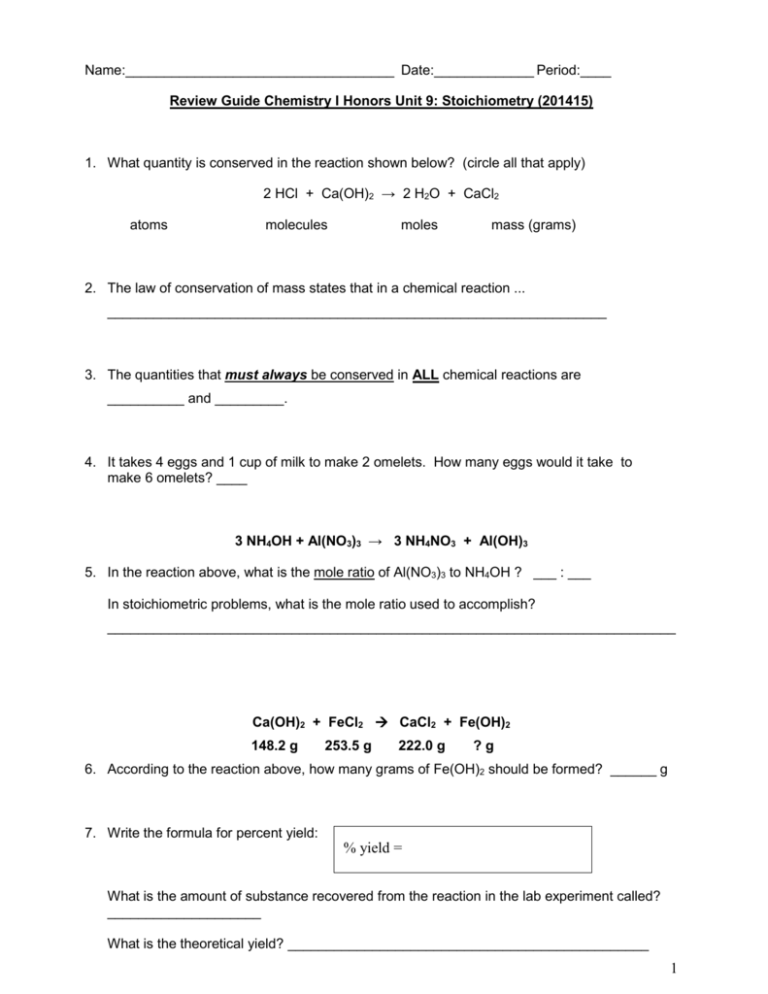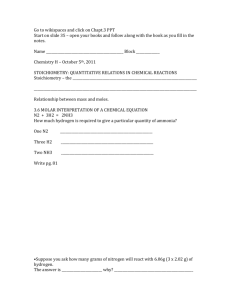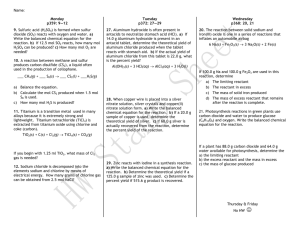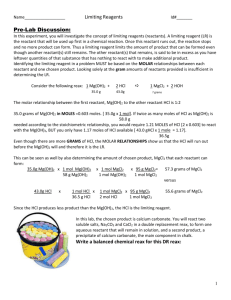CHH Review Guide Unit 9 student 201415
advertisement

Name:___________________________________ Date:_____________ Period:____ Review Guide Chemistry I Honors Unit 9: Stoichiometry (201415) 1. What quantity is conserved in the reaction shown below? (circle all that apply) 2 HCl + Ca(OH)2 → 2 H2O + CaCl2 atoms molecules moles mass (grams) 2. The law of conservation of mass states that in a chemical reaction ... _________________________________________________________________ 3. The quantities that must always be conserved in ALL chemical reactions are __________ and _________. 4. It takes 4 eggs and 1 cup of milk to make 2 omelets. How many eggs would it take to make 6 omelets? ____ 3 NH4OH + Al(NO3)3 → 3 NH4NO3 + Al(OH)3 5. In the reaction above, what is the mole ratio of Al(NO3)3 to NH4OH ? ___ : ___ In stoichiometric problems, what is the mole ratio used to accomplish? __________________________________________________________________________ Ca(OH)2 + FeCl2 CaCl2 + Fe(OH)2 148.2 g 253.5 g 222.0 g ?g 6. According to the reaction above, how many grams of Fe(OH)2 should be formed? ______ g 7. Write the formula for percent yield: % yield = What is the amount of substance recovered from the reaction in the lab experiment called? ____________________ What is the theoretical yield? _______________________________________________ 1 SHOW ALL WORK --- BOX your ANSWER 8. 4 Na + O2 2 Na2O a) How many moles of sodium will react completely with 3.82 moles of oxygen (O2)? b) How many moles of Na2O can be produced from 13.5 mol Na? c) How many moles of O2 are needed to produce 34.7 g Na2O (61.98 g/mol)? 9. C2H4 + 3 O2 2 CO2 + 2 H2O a) When 0.624 mol O2 are reacted, how many moles of carbon dioxide are produced? b) How many grams of C2H4 (28.06 g/mol) are needed to produce 3.70 moles of water? c) How many grams of O2 are needed to react with 2.56 g C2H4 (28.06 g/mol)? 2 SHOW ALL WORK --- BOX your ANSWER 10. N2 + 3 F2 2 NF3 a) When 62.0 g of fluorine (F2) are reacted, how many mol NF3 (71.01 g/mol) will form? b) How many mol N2 are needed to produce 2.85 g NF3 (71.01 g/mol)? c) 3.54 g of nitrogen (N2) will react with how many grams of fluorine (F2)? 11. 4 NH3 + 7 O2 4 NO2 + 6 H2O a) What mass of NO2 (46.01 g/mol) can be produced from 3.50 mol O2? b) 13.8 g NH3 (17.04 g/mol) would be able to produce how many mol H2O? c) How many grams of O2 are needed to produce 15.5 g H2O? 3 SHOW ALL WORK --- BOX your ANSWER 12. Be + 2 HCl BeCl2 + H2 Enough Be and HCl were added to produce 10.7 grams of beryllium chloride (BeCl2), but only 4.50 g BeCl2 was actually recovered. What is the percent yield? 13. 2 LiOH + FeCl2 2 LiCl + Fe(OH)2 a) You began this reaction with 20.0 grams of lithium hydroxide (LiOH) (23.95 g/mol). What is the theoretical yield of lithium chloride (LiCl) (42.39 g/mol) ? b) You actually produced 31.1 grams of LiCl. What is the percent yield? 14. C3H8 + 5 O2 3 CO2 + 4 H2O Propane (C3H8) is combusted with oxygen gas as shown above. If an actual yield of 6.50 g of water product is recovered by combusting 5.00 grams of C3H8 (44.11 g/mol), what is the percent yield of water in the reaction? 15. In a chemical reaction, the limiting reactant is the one that is _____________________ when the reaction is completed. The other reactant is called the ____________________ because it is _______________ when the reaction is completed. The ______________ reactant is used to determine the maximum amount of product that can be produced. 4 16. Consider the reaction in which 2 moles of reactant A are added to 3 moles of reactant B. Which reactant is limiting? A. reactant A B. reactant B C. need more information Explain your answer: _________________________________________________________ __________________________________________________________________________ SHOW ALL WORK --- BOX your ANSWER 2 C(s) + O2(g) 2 CO(g) 17. Solid carbon reacts with oxygen gas to produce carbon monoxide gas as shown above. Identify the limiting reactant when 3.25 mol O2 is reacted with 48.5 g C . N2(g) + 3 H2(g) 2 NH3(g) 18. Nitrogen gas reacts with hydrogen gas to form ammonia (NH3) as shown above. What is the theoretical yield of NH3 (17.04 g/mol) that can be formed when 10.0 g N2 is reacted with 10.0 g H2 ? 5










